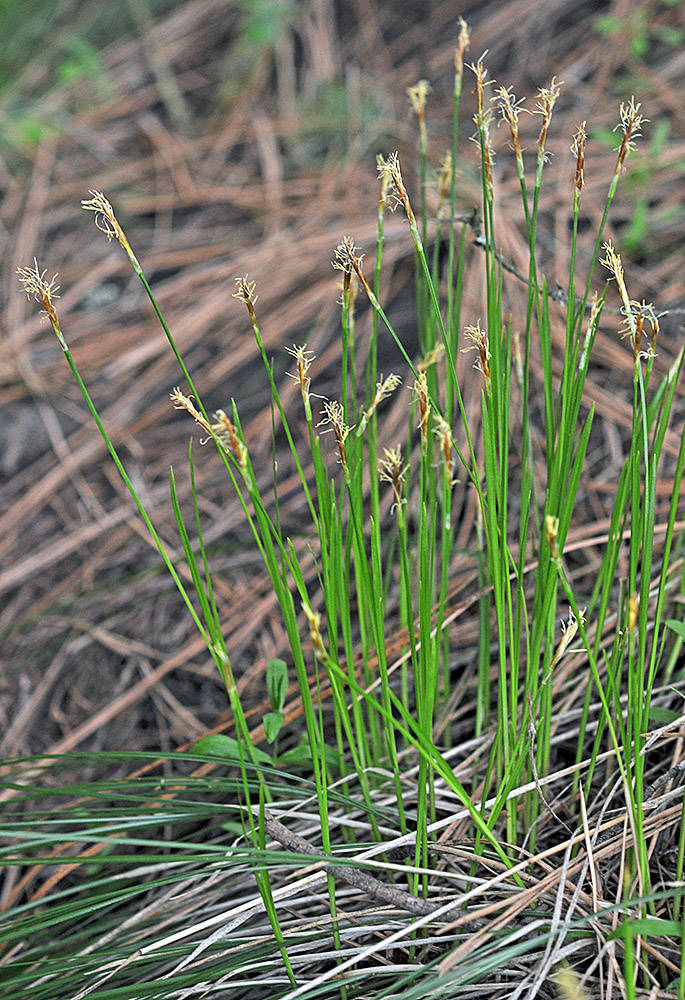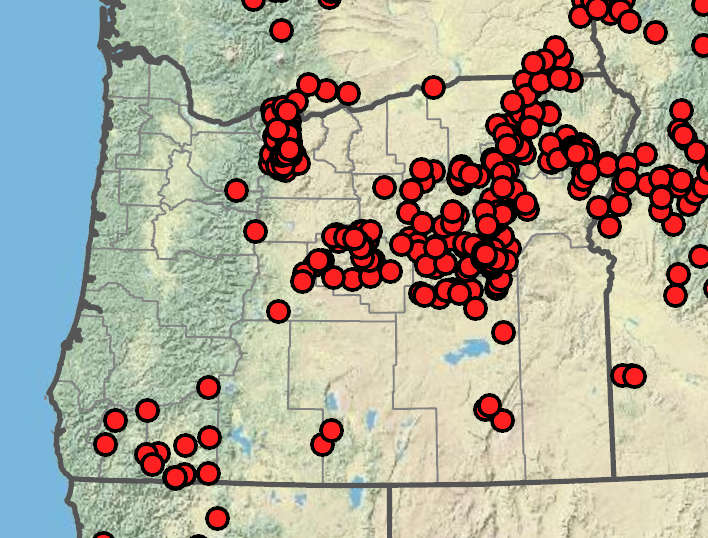|
elk sedge
|
lateral sedge, one-sided sedge
|
| Plants loosely cespitose or short rhizomatous, with thick, dark, shallow rhizomes; culms 12–50 cm, triangular in cross section. |
Plants cespitose, 35–75 cm tall. |
1.1–3.5 mm wide; flat; evergreen; leathery; as long as or longer than the culms. |
2–3(4) mm wide. |
spike solitary, androgynous, lacking inflorescence bracts; male terminal portion 1–2.5 cm long, separated from the 1–3 perigynia by a short internode. |
(1)1.4–2.5 cm × 9–17 mm; dense and head-like, usually tilted to one side; bracts leaf-like; longer than the inflorescence; spikes gynaecandrous. |
obovate, rounded at the top, 5–7(8.5) × 1.8–2.8 mm, green; whitish, or brown; beak small; stigmas 3. |
ovate to lanceolate, 3.5–5 × 1.3–1.75 mm, cream-colored to light brown, with 0–11 dorsal veins; wings 0.2–0.3 mm wide; beak tip usually winged and ciliate-serrulate to the tip; but occasionally unwinged, brown; parallel-sided; and entire for the distal 0.5–0.6 mm; (1.4)1.7–2.5 mm from achene top to beak tip; stigmas 2. |
trigonous. |
lenticular; (1.2)1.5–1.9 × 0.75–1(1.2) mm. |
the lower longer than the perigynia; the upper reduced; more or less brown with paler midrib and margins, pointed to awned. |
3.3–4.8 mm long; shorter and narrower than the perigynia; gold to brown with midrib green or gold. |
|
|
|
|
|
|
|
Well-drained soils in dry, open, conifer forests, aspen stands, and openings, rarely in sagebrush, on both serpentine and nonserpentine substrates. 100–2500 m. BR, BW, Col, ECas, Lava, Owy, Sisk. CA, ID, NV, WA; north to southeastern British Columbia, east to CO, PA. Native. Carex geyeri is a common ground cover in open forest, especially in northeastern Oregon, recognized by its tough, flat, evergreen leaves from dark, scaly rhizomes. Similar pinegrass, Calamagrostis rubescens, usually has hairy internodes and when in flower it is easily distinguished. Carex geyeri is important food for wildlife and livestock, especially in winter. In southwestern Oregon, C. geyeri can be confused with C. multicaulis, which is densely cespitose and has proportionately shorter, usually involute leaves, and longer, green, leaf-like, lower female scales. |
Wet prairies, vernal pools, pond margins, marshes, road ditches and other seasonally wet places. 0–1300 m. Casc, CR, Est, WV. CA, WA; north to British Columbia; Japan. Native. With its long, leaf-like bracts and inflorescence angled to one side of the culm, C. unilateralis is usually easy to identify. Some plants are intermediate between this and C. athrostachya, which lives mainly east of the Cascades but occasionally on the west side. Carex athrostachya inflorescences are erect, perched directly atop the culm, and its lower inflorescence bracts are more bristle-like. Its beaks are unwinged, brown, and entire, but in C. unilateralis the majority of beaks are flattened and ciliate-serrulate almost to the tip. |
Flora of Oregon, volume 1, page 202
Barbara Wilson, Richard Brainerd, Nick Otting |
Flora of Oregon, volume 1, page 231
Barbara Wilson, Richard Brainerd, Nick Otting |
C. abrupta, C. agastachys, C. amplifolia, C. angustata, C. aperta, C. aquatilis, C. arcta, C. arenaria, C. atherodes, C. athrostachya, C. atrosquama, C. aurea, C. barbarae, C. bebbii, C. bolanderi, C. brainerdii, C. brevior, C. breweri, C. buchananii, C. buxbaumii, C. californica, C. canescens, C. capillaris, C. capitata, C. chordorrhiza, C. comans, C. comosa, C. concinna, C. concinnoides, C. cordillerana, C. crawfordii, C. cusickii, C. davyi, C. deflexa, C. densa, C. diandra, C. disperma, C. distans, C. douglasii, C. duriuscula, C. echinata, C. exsiccata, C. feta, C. filifolia, C. fissuricola, C. fracta, C. gynocrates, C. gynodynama, C. halliana, C. harfordii, C. hassei, C. haydeniana, C. hendersonii, C. heteroneura, C. hirsutella, C. hirta, C. hoodii, C. hystericina, C. idahoa, C. illota, C. infirminervia, C. inops, C. integra, C. interior, C. interrupta, C. jonesii, C. kelloggii, C. klamathensis, C. kobomugi, C. laeviculmis, C. lasiocarpa, C. leporina, C. leporinella, C. leptalea, C. leptopoda, C. limosa, C. livida, C. longii, C. luzulina, C. lyngbyei, C. macrocephala, C. macrochaeta, C. media, C. mendocinensis, C. mertensii, C. mesochorea, C. micropoda, C. microptera, C. multicaulis, C. nardina, C. nebrascensis, C. nervina, C. neurophora, C. nigricans, C. nudata, C. obnupta, C. pachycarpa, C. pachystachya, C. pansa, C. paysonis, C. pellita, C. pelocarpa, C. pendula, C. petasata, C. phaeocephala, C. pluriflora, C. praeceptorum, C. praegracilis, C. praticola, C. preslii, C. pumila, C. raynoldsii, C. retrorsa, C. rossii, C. saxatilis, C. scabriuscula, C. scirpoidea, C. scoparia, C. scopulorum, C. serpenticola, C. serratodens, C. sheldonii, C. simulata, C. spectabilis, C. stipata, C. straminiformis, C. subbracteata, C. subfusca, C. subnigricans, C. sychnocephala, C. tahoensis, C. tiogana, C. tribuloides, C. tumulicola, C. unilateralis, C. utriculata, C. vallicola, C. vernacula, C. vesicaria, C. viridula, C. vulpinoidea, C. whitneyi, C. zikae |
C. abrupta, C. agastachys, C. amplifolia, C. angustata, C. aperta, C. aquatilis, C. arcta, C. arenaria, C. atherodes, C. athrostachya, C. atrosquama, C. aurea, C. barbarae, C. bebbii, C. bolanderi, C. brainerdii, C. brevior, C. breweri, C. buchananii, C. buxbaumii, C. californica, C. canescens, C. capillaris, C. capitata, C. chordorrhiza, C. comans, C. comosa, C. concinna, C. concinnoides, C. cordillerana, C. crawfordii, C. cusickii, C. davyi, C. deflexa, C. densa, C. diandra, C. disperma, C. distans, C. douglasii, C. duriuscula, C. echinata, C. exsiccata, C. feta, C. filifolia, C. fissuricola, C. fracta, C. geyeri, C. gynocrates, C. gynodynama, C. halliana, C. harfordii, C. hassei, C. haydeniana, C. hendersonii, C. heteroneura, C. hirsutella, C. hirta, C. hoodii, C. hystericina, C. idahoa, C. illota, C. infirminervia, C. inops, C. integra, C. interior, C. interrupta, C. jonesii, C. kelloggii, C. klamathensis, C. kobomugi, C. laeviculmis, C. lasiocarpa, C. leporina, C. leporinella, C. leptalea, C. leptopoda, C. limosa, C. livida, C. longii, C. luzulina, C. lyngbyei, C. macrocephala, C. macrochaeta, C. media, C. mendocinensis, C. mertensii, C. mesochorea, C. micropoda, C. microptera, C. multicaulis, C. nardina, C. nebrascensis, C. nervina, C. neurophora, C. nigricans, C. nudata, C. obnupta, C. pachycarpa, C. pachystachya, C. pansa, C. paysonis, C. pellita, C. pelocarpa, C. pendula, C. petasata, C. phaeocephala, C. pluriflora, C. praeceptorum, C. praegracilis, C. praticola, C. preslii, C. pumila, C. raynoldsii, C. retrorsa, C. rossii, C. saxatilis, C. scabriuscula, C. scirpoidea, C. scoparia, C. scopulorum, C. serpenticola, C. serratodens, C. sheldonii, C. simulata, C. spectabilis, C. stipata, C. straminiformis, C. subbracteata, C. subfusca, C. subnigricans, C. sychnocephala, C. tahoensis, C. tiogana, C. tribuloides, C. tumulicola, C. utriculata, C. vallicola, C. vernacula, C. vesicaria, C. viridula, C. vulpinoidea, C. whitneyi, C. zikae |
| |
BC,
CA,
OR,
WA
CalFlora,
CalPhotos,
Flora NW,
PNW Herbaria
WildflowerSearch
iNaturalist (observations)
USDA Plants Database
BC,
CA,
OR,
WA
CalFlora,
CalPhotos,
Flora NW,
PNW Herbaria
WildflowerSearch
iNaturalist (observations)
USDA Plants Database





